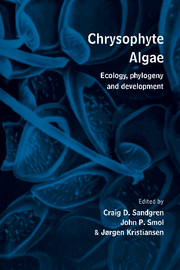Book contents
- Frontmatter
- Contents
- Preface
- List of contributors
- 1 History of chrysophyte research: origin and development of concepts and ideas
- Part I Phylogeny, systematics and evolution
- 2 Evolution of plastid genomes: inferences from discordant molecular phylogenies
- 3 A modern concept of chrysophyte classification
- 4 Current status of chrysophyte ‘splinter groups’: synurophytes, pedinellids, silicoflagellates
- Part II Development, physiology and nutrition
- Part III Ecology, paleoecology and reproduction
- Part IV Contributed original papers
- Index of scientific names
- Subject index
4 - Current status of chrysophyte ‘splinter groups’: synurophytes, pedinellids, silicoflagellates
Published online by Cambridge University Press: 05 March 2012
- Frontmatter
- Contents
- Preface
- List of contributors
- 1 History of chrysophyte research: origin and development of concepts and ideas
- Part I Phylogeny, systematics and evolution
- 2 Evolution of plastid genomes: inferences from discordant molecular phylogenies
- 3 A modern concept of chrysophyte classification
- 4 Current status of chrysophyte ‘splinter groups’: synurophytes, pedinellids, silicoflagellates
- Part II Development, physiology and nutrition
- Part III Ecology, paleoecology and reproduction
- Part IV Contributed original papers
- Index of scientific names
- Subject index
Summary
Introduction
Classification of the chrysophytes sensu lato is presently in a state of flux which increasingly recalls the problems encountered in classification of the green algae. Christensen (1980) included all chrysophytes in a single class Chrysophyceae, with seven orders. A much more restricted concept was suggested by Hibberd (1976) who proposed to include in the Chrysophyceae only species with the Ochromonas type of organization. Hibberd (1986) excluded silicoflagellates, pedinellids and bicosoecids, and his ideas were accepted by Kristiansen (1986, 1990). Subsequently, Andersen (1987), on the basis of pigment and ultrastructural data, suggested separating the Synura group into a class of its own, the Synurophyceae.
Below I first summarize some of the features of the pedinellids, synurophytes and silicoflagellates, as presently known. A classification into three classes is then suggested. It is argued that photoautotrophs such as Ochromonas and its allies in the Ochromonadales are not necessarily the most primitive chrysophytes. It is equally or even more parsimonious, considering the endosymbiosis theory for the origin of chloroplasts, that heterotrophic, apoplastidic species such as members of the Bicosoeca group or, less likely, apoplastidic pedinellids such as Actinomonas and Pteridomonas, may represent the most primitive chrysophytes.
The idea of the Bicosoeca group as a separate class is no longer justified. Members of this group are closely related to the Ochromonadales, differing mainly in the presence of non-silicified resting stages instead of silicified stomatocysts.
- Type
- Chapter
- Information
- Chrysophyte AlgaeEcology, Phylogeny and Development, pp. 75 - 92Publisher: Cambridge University PressPrint publication year: 1995
- 23
- Cited by



